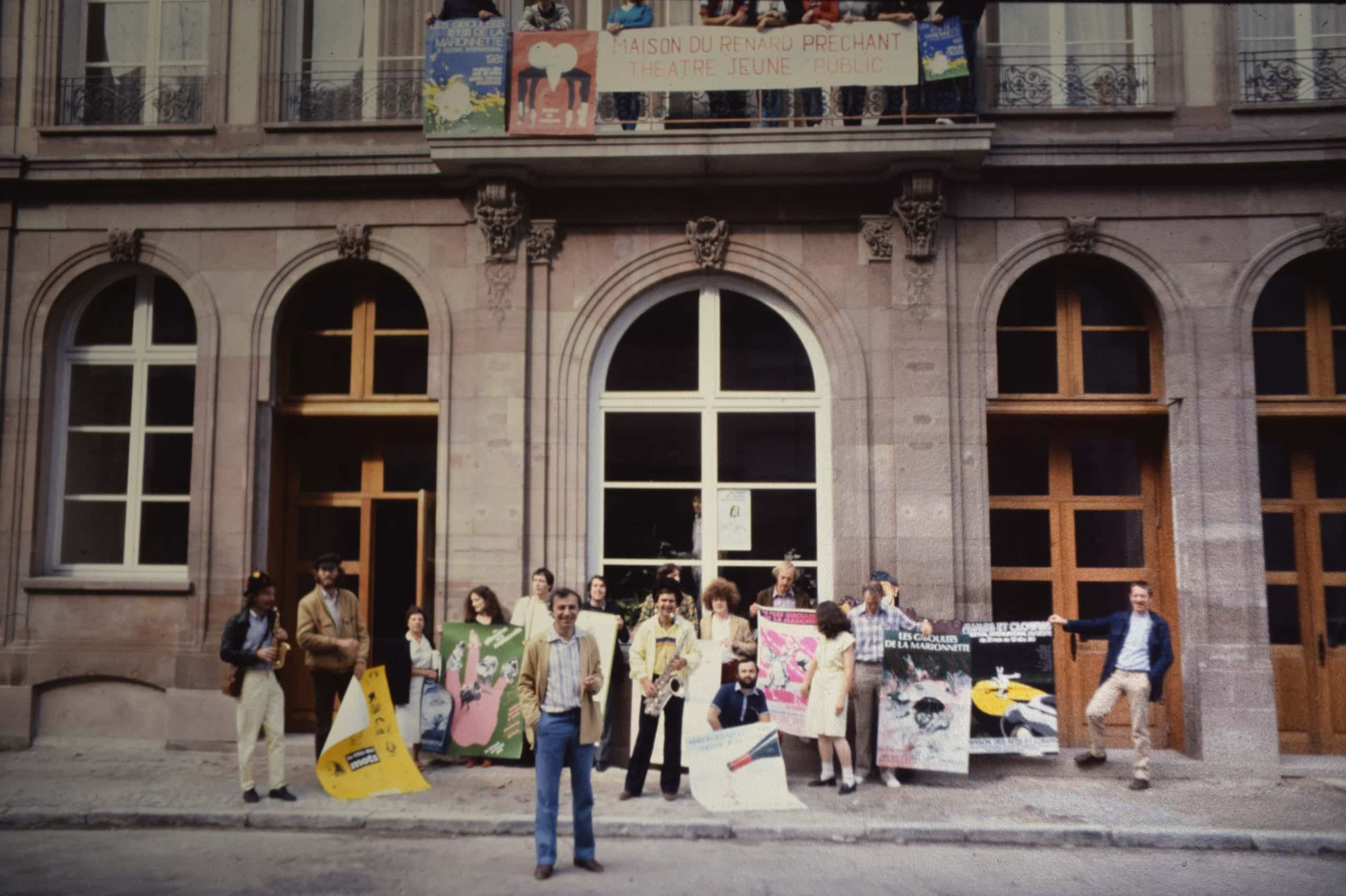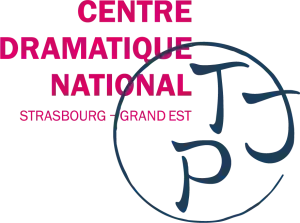L'HISTOIRE DU TJP
From the Maison des Arts et Loisirs to the CDN
50 years of stories...


UNCONVENTIONAL ARTISTIC FORMS: PUPPETRY, MIME, STORYTELLING, STREET ART
In 1974, the city of Strasbourg created the Maison des Arts et Loisirs (MAL) on rue du Pont Saint-Martin, in the heart of the Petite-France district. Actor André Pomarat, a graduate of Groupe I of the École Supérieure d'Art Dramatique and now a professor at the school, had just left the Théâtre National de Strasbourg.
With its committed and engaging programming, the MAL quickly opened up to artistic practices that were then ignored by theatrical institutions: storytelling, poetry, puppetry, mime and street arts. Four highlights, Animations de la Petite-Francethe Giboulées de la marionnette, Mimes and clowns and Fête des mots now punctuate the seasons. In every field, the MAL brings together regional, national and international artists, focusing on the unclassifiable and the inventors of new forms, working to renew and cross-fertilize disciplines.
This is how the public can see, for example:
> At the Giboulées de la marionnette (created in 1977): Philippe Genty, Figurentheater Triangel, Björn Fühler, Compagnie Daru, Teatro Gioco Vita...
> À Mimes and clowns (1978-1987): Claire Heggen and Yves Marc, Jango Edwards, Hector Malamud, the Mummenschanz, the Scalzacani...
> To the Fête des mots (from 1979 to 1986): Valère Novarina, Abbi Patrix, Roland Engel, l'Attroupement 2 by Patrick Le Mauff, the Théâtre Populaire Romand...
The second French festival devoted to puppet theater after Charleville-Mézières, Les Giboulées has established itself as the must-attend event for this art form in full metamorphosis. Their success led the MAL /TJP, which became the Centre Dramatique National pour l'Enfance et la Jeunesse in 1991, to specialize in this field. Grégoire Callies, who succeeded André Pomarat in 1997, perpetuated the place of puppetry within the CDN.
Renaud Herbin, appointed director in 2012, continues this long tradition of discovering new forms, exploring the uncharted territories between Body, Object and Image.
ARTISTIC ACTIONS IN THE CITY: CREATION AND TRANSMISSION
The artists invited by the MAL / TJP are not only present through their shows. Activities, workshops and artistic courses give these creators of new languages the opportunity to extend their research, while offering Strasbourg audiences other ways of meeting them.
Every early summer, the Animations de la Petite-France, one of the highlights of the season, offers residents of this then-popular district film screenings, free shows, concerts, balls and sporting events. From 1982 onwards, in partnership with other cultural establishments such as the Opéra du Rhin and the Service Éducatif des Musées, storytellers, comedians, musicians and visual artists took over the city, intervening in different places for conferences, visits and actions to prepare and refine the reception of a show.
1985 saw the birth of an original initiative: the Tremplin Jeune Théâtre, an annual "awakening to theatrical practices" cycle that enables dozens of young people, aged between 14 and 23, to engage in artistic practice (playwriting, acting, mime, singing, dance, manipulation) and discover the creative professions. A common thread: the way these young people look at the contemporary world. One objective: a public presentation of the writing work carried out by the participants.
A number of proposals enable the MAL/TJP to affirm even more strongly the place of artists in the city and the region.
Today, numerous workshops continue this legacy, combining transmission and creation. Numerous artistic projects supported by the TJP invent new ways of interacting with the city and its region.
A THEATER OPEN TO ALL, INCLUDING THE VERY YOUNG
Since 1974, as a place for artistic creation and action, the MAL has been carrying out projects aimed at the very young. André Pomarat established the idea that the establishment was open to all, including children and teenagers, at a time when artists working for young audiences were suffering from a lack of production and distribution resources. By asserting that theater concerns all audiences, whatever their age, the MAL/TJP creates the conditions for the professional development of these practices; it becomes an exemplary and driving force, an international reference.
Reaching out to all audiences, the MAL/TJP extends its partnership with schools far beyond the Strasbourg conurbation, to the Bruche Valley and Sainte-Marie-aux-Mines. But above all, the aim is to bring spectators together, so that young and old can share a common artistic emotion. Heir to Jean Dasté, a leading figure in decentralization, and to his daughter Catherine Dasté, a pioneer of theater for young audiences, André Pomarat knows that encounters with art are crucial to combating inequality and helping to shape the sensibilities of those who will become future citizens. He likes to quote Russian director Constantin Stanislavski's response to Léon Chancerel, founder of the Association pour le Théâtre et la Jeunesse, who asked him how to act in front of children: "Like in front of adults, but better."
To achieve this, André Pomarat surrounded himself with collaborators who shared his commitment and convictions: Philippe Dorin, Éric de Dadelsen, Pierre Halet, Ève Ledig and many others... It was the era of the Island driver (1982), from See Brant (1982), d'Ogrrre ! (1985), by Mowgli, the wolf-child (1988), from Ram-Dam or the sound mirror (1989). The productions went on extensive national and international tours, while guest companies from France and abroad came to create or present their shows: Amoros et Augustin (Sunjata, l'épopée mandingue, 1989), Parma's Teatro delle Briciole and Geneva's Théâtre Am Stram Gram.
As the MAL/TJP continues its work, this attention to the needs of all remains at the heart of today's CDN project, which encourages a genuine generational mix.
SMALL AND LARGE STAGES: THE ESSENTIAL DEVELOPMENT OF THE PROJECT
Creating an institution also means investing in places. Over the years, André Pomarat convinced the City of Strasbourg of the need to develop his project, first at the Petite Scène and then at the Grande Scène. Considerable energy was expended in obtaining the support of elected officials, negotiating and discussing with municipal departments, and thinking up, designing and fitting out the allocated spaces.
The birth of the MAL in the Saint-Martin church, a neo-Gothic Protestant temple built in 1905 and disused since 1969, is inextricably linked with the Petite-France district, then predominantly working-class. For several weeks in June, its courtyards, squares and streets are taken over by brass bands, outdoor shows, concerts and merry-go-rounds.
But within its walls, with a 200-seat performance hall, the MAL/TJP soon found itself cramped for space. The multiplication of creative and programming activities and the growing influx of audiences meant that other spaces were needed. While "Mimes et clowns" can take advantage of Raymond Roumegous' Fatrasie big top, other shows require a large venue to be presented to a wide audience.
As early as June 1977, under the impetus of cultural deputy Germain Muller, the city of Strasbourg planned to allocate the Maison du Renard Prêchant, a former cinema located at 7 rue des Balayeurs, in the Krutenau district, to the MAL. However, the Grande Scène was not inaugurated until 1982, after a series of twists and turns involving the city's technical services and two successive architectural firms. This gave the MAL/TJP a second facility: a 400-seat auditorium with a stage measuring approximately 10 x 8.5 m. In 1996, following its renovation, the Petite Scène was equipped with a cafeteria that could be used as a performance space.
In 2009, while the Théâtre Jeune Public was being directed by Grégoire Callies, the renovated Grande Scène was renamed Salle André Pomarat by unanimous decision of the City Council.
Even today, the TJP's spaces need to be rethought in the light of changing uses.
ANDRÉ POMARAT: A PIONEER OF DECENTRALIZATION
As an heir to the theatrical decentralization movement, André Pomarat claims a triple filiation: that of André Clavé (director of the Centre Dramatique de l'Est from 1947 to 1951), that of Michel Saint-Denis (founder in 1954 of the École Supérieure d'Art Dramatique de Strasbourg, of which he was a student) and that of Hubert Gignoux (director of the Centre Dramatique de l'Est from 1957 to 1971), who hired him into the permanent troupe of what was to become the Théâtre National de Strasbourg in 1968.
Inspired by these three models, and backed by his reputation as an actor and teacher at the TNS, André Pomarat embarked on a new Strasbourg adventure in 1974, setting up the Maison des Arts et Loisirs, with the help of a close-knit, militant team. The Compagnie du Théâtre Jeune Public was born in 1982: the MAL then became MAL/TJP, Centre Régional du Théâtre Jeune Public, before completing its transformation in 1991 with the creation of the 6th Centre Dramatique National pour l'Enfance et la Jeunesse, directed by Pomarat until 1997.
During these years of intense activity, André Pomarat, who came to the theater for the love of words, had to limit his acting commitments. He did, however, take part in a number of projects that were close to his heart, including in 1985 The Legend of the Centuries by Victor Hugo, directed by François Lazaro, won three prizes at the Festival Off d'Avignon.
As a young man, André Pomarat dreamed of becoming an architect. A man of a single building, but one that he knew how to grow until it became a first-rate institution, he simultaneously travelled the roads of Alsace with a decentralized and sometimes bilingual program, toured his productions throughout France and Europe, and opened his theater to international artists.
Aware of Strasbourg's strategic position, André Pomarat began dreaming of a European Dramatic Centre for Children and Young People in 1987.
Today, international openness is an essential component of the artistic landscape. The TJP is increasingly keen to develop partnerships with European artists and institutions.

